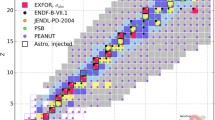Abstract
The atmosphere of Mars significantly attenuates the heavy ion component of the primary galactic cosmic rays (GCR), however, increases the fluence of secondary light ions (neutrons, and hydrogen and helium isotopes) because of particle production processes. We describe results of the quantum multiple scattering fragmentation (QMSFRG) model for the production of light nuclei through the distinct mechanisms of nuclear abrasion and ablation, coalescence, and cluster knockout. The QMSFRG model is shown to be in excellent agreement with available experimental data for nuclear fragmentation cross sections. We use the QMSFRG model and the space radiation transport code, HZETRN to make predictions of the light particle environment on the Martian surface at solar minimum and near maximum. The radiation assessment detector (RAD) experiment will be launched in 2009 as part of the Mars Science Laboratory (MSL). We make predictions of the expected results for time dependent count-rates to be observed by the RAD experiment. Finally, we consider sensitivity assessments of the impact of the Martian atmospheric composition on particle fluxes at the surface.



Similar content being viewed by others
References
Cucinotta FA, Durante M (2006) Cancer risks from exposures to galactic cosmic rays: implications for space exploration by human beings. Lancet Oncol 7:431–435
Cucinotta FA, Schimmerling W, Wilson JW, Peterson LE, Badhwar GD, Saganti P, Dicello JF (2001) Space radiation cancer risks and uncertainties for Mars missions. Radiat Res 156:682–688
Saganti PB, Cucinotta FA, Wilson JW, Simonsen LC, Zeitlin CJ (2004) Radiation climate map for analyzing risks to astronauts on the Mars surface from galactic cosmic rays. Space Sci Rev 110:143–156
Badhwar GB, Cucinotta FA, O’Neill PM (1994) An analysis of interplanetary space radiation exposure for various solar cycles. Radiat Res 138:201–208
Clowdsley M, Wilson JW, Kim MH, Singleterry RC, Tripathi, RK, Heinbockel JH, Badavi FF, Shinn JL (2001) Neutron environments on the Martian surface. Phys Medica XVII:94–96
Cucinotta FA, Townsend LW, Wilson JW (1992) Production of 3H at large momentum in α-12C collisions at 2A GeV. Phys Lett 282B:1–6
Cucinotta FA, Townsend LW, Wilson JW (1992) Multiple scattering effects in quasi-elastic α-4He scattering. Phys Rev C 46:1451–1456
Cucinotta FA, Dubey RR (1994) Alpha cluster description of excitation energies in 12C (12C, 3 α) X at 2.1 GeV. Phys Rev C 50:979–984
Cucinotta FA et al (1997) Computational procedures and data-base development. In: Wilson JW, Miller J, Konradi A, Cucinotta FA (eds) NASA workshop on shielding strategies for human space exploration. NASA CP-3360
Cucinotta FA, Wilson JW, Townsend LW (1997) Abrasion–ablation model for neutron production in heavy ion collisions. Nucl Phys A 619:202–212
Campi X, Hufner J (1981) Nuclear spallation–fragmentation reactions induced by high-energy projectiles. Phys Rev C 24:2199–2209
Cucinotta FA (1994) Forward production of protons in relativistic 12C-nucleus collisions. J Phys G Nucl Part Phys 20:1803–1815
Leupold S, Heinz U (1994) Coalescence model for deuterons and anti-deuterons in relativistic heavy–heavy ion collisions. Phys Rev C50:1110–1128
Wilson JW, Badavi FF (1986) Methods of galactic heavy ion transport. Radiat Res 108:231–237
Wilson JW, Townsend LW, Schimmerling W, Khandelwal GS, Khan F, Nealy JE, Cucinotta FA, Simonsen LC, Shinn JL, Norbury JW (1991) Transport methods and interactions for space radiations. NASA RP-1257
Cucinotta FA, Wilson JW, Saganti P, Hu X, Kim MY, Cleghorn T, Zeitlin C, Tripathi RK (2006) Isotopic dependence of GCR fluence behind shielding. Radiat Meas 41:1235–1249
Zeitlin C, Fukumura A, Guetersloh SB, Heilbronn LH, Iwata Y, Miller J, Murakami T (2006) Fragmentation cross sections of 28Si at beam energies from 290 A to 1200 A MeV. Nucl Phys A (in press)
Olsen DL, Berman BL, Greiner DE, Heckman HH, Lindstrom PJ, Crawford HJ (1981) Factorization of fragment-production cross sections in relativistic heavy-ion collisions. Phys Rev C28:1602–1613
Krasnopolsky VA, Maillard JP, Owen TC (2004) Detection of methane in the martian atmosphere: evidence for life? Icarus 172:537–547
Formisano V, Atreya S, Encrenaz T, Ignatiev N, Giuranna M (2004) Detection of methane in the atmosphere of Mars. Science 306:1758–1761
Acknowledgment
This work was sponsored, in-part, by the NASA Exploration Systems Management Directorates Space Radiation Research Programs Radiation Risk Assessment (F.A. Cucinotta) and Mars Science Laboratory Awards (D. Hassler).
Author information
Authors and Affiliations
Corresponding author
Rights and permissions
About this article
Cite this article
Cucinotta, F.A., Kim, MH., Schneider, S.I. et al. Description of light ion production cross sections and fluxes on the Mars surface using the QMSFRG model. Radiat Environ Biophys 46, 101–106 (2007). https://doi.org/10.1007/s00411-007-0099-y
Received:
Accepted:
Published:
Issue Date:
DOI: https://doi.org/10.1007/s00411-007-0099-y




